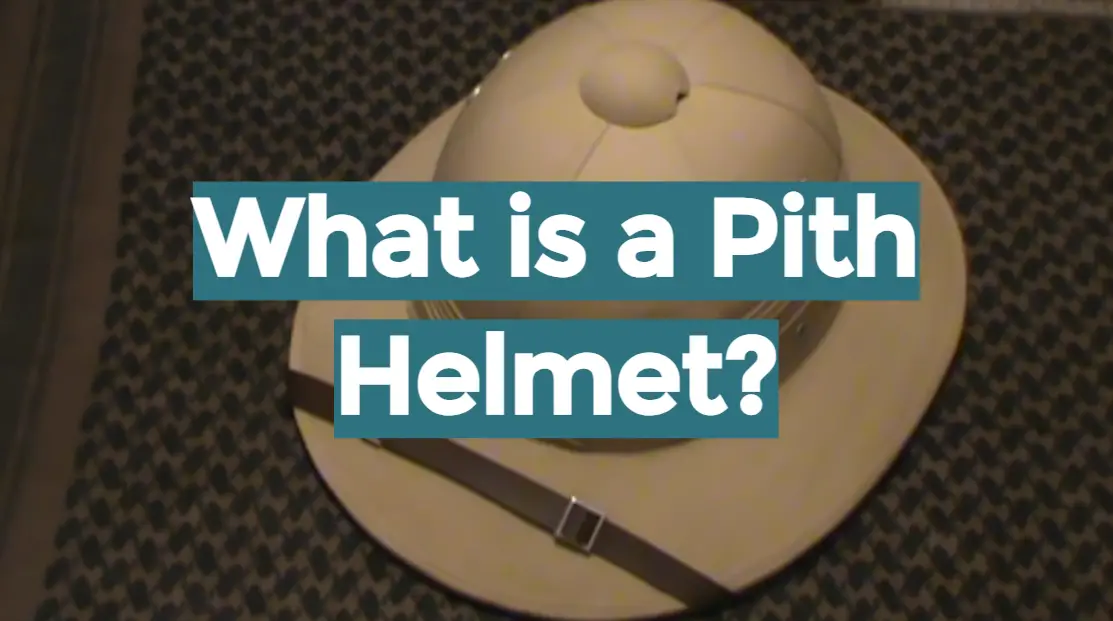A pith helmet (you may know it as a safari hat) is a lightweight protective headgear for the hot and humid climate of Africa. This type of hat is often associated with Europeans in Africa because it was popularized by European explorers to protect themselves from the sun. The hats were originally made from plant fibers called pith that are found near areas where bamboo grows. This guide focuses on the different features and styles of a pith helmet.
Table of Contents
The Original Pith Helmet features
This helmet features a cork frame with a lightweight cotton area. The helmet is constructed to protect the head against direct sunlight, while also providing ventilation for hot air to escape.
The pith helmet is an essential part of any jungle outfit, as it protects against direct sunlight and keeps your body cool by allowing hot air to escape through vents in the sides. This style of hat was made popular during British colonial rule and has been a staple item ever since then for those who choose to explore outside or enjoy time at the beach.
A wide-brimmed version like this one is perfect for anyone interested in protecting their skin tone from harmful UV rays but still wants some sun coverage without limiting peripheral vision too much. Remember that even though you can see what’s going on around you better with sunglasses covering most of your face, they also make it harder to see potentially hazardous rocks or branches at the ground level.
Other names for the Pith Helmet:
- sun helmet;
- safari helmet/hat;
- sola topee;
- topee;
- topi;
- salacot [1];
History of pith helmets/headgear
Early models of pith helmets
This headgear is a form of conventional Filipino helmet that has been worn for centuries and resembles a salakot (in some countries this term is still used to describe pith helmets). They are generally dome- or cone-shaped, with wide brims. This headgear can range in size from almost narrow to wide. The crown’s tip typically features a metal or wood spike or knobbed finial. It’s secured by an inner headband and also it has a chinstrap.
Originally these helmets were constructed of lightweight materials including:
- rattan;
- woven bamboo;
- bottle gourd;
- coconut fiber;
Also, it may include precious metals, waterproof resin, or cloth added as desired.
The distinctive shaped early headgear got its name from the Colonial pattern helmet, which was designed with a high crown and low back [2].
Military use, naval use, governmental use
Once again according to Wikipedia, the pith helmet was widely worn by British, Belgian, French, Austrian-Hungarian, and German soldiers in the Middle East and Africa during the First World War.
The locally raised forces in the Philippines (including the army and a gendarmerie) used sun helmets that were mostly constructed of compressed coconut fiber known as “Guinit” during the 1930s. The Axis Second Philippine Republic’s military, known as the Bureau of Constabulary, as well as guerrilla organizations in the Philippines, utilized this headdress.
Also, pith helmets were used since then for naval and governmental use. For example, nowadays it is used by a number of military units in the United Kingdom, United States, Netherlands, and Vietnam.
Pith helmets are also worn by motorbike taxi drivers in Hanoi, Cameroonian police officers, and Peruvian cops. Postal workers in the United States wear pith helmets when it’s particularly wet or bright outside as part of their uniforms on extremely rainy or sunny days, and marksmanship coaches at the shooting range for the U.S. Marine Corps.
Summing up, it was primarily used as part of military uniforms in Africa. A major difference between a pith helmet and other militaristic helmets is that while others tend to cover all or at least most of the head, the top half only typically covers around where your ears are located, leaving much skin exposed to sunlight.
In popular culture
A pith helmet is most popularly worn by explorers and safari hunters. In the United States, safari hats were frequently worn in the subtropics, and Teddy Roosevelt was seen wearing his own pith helmet [3]. A lot of celebrities of Hollywood wore these hats in the movies about safari and jungle adventures.
Modern commercial models of Pith helmets:
1) British, French and German
Pith helmets are lightweight hats made of the pith plant. The hat was popular in tropical regions during the Victorian era due to its protection from the harsh sun and ability to keep cool by protecting sweat on your head. Today, they’re still used in hot climates like Africa where people put ice inside their hats or soak them with water before wearing them in order to stay cool.
Many countries including UK, Germany, and France have started using different styles of these piths instead making it easier for individuals who live there to wear what they deem comfortable without looking out-of-place compared to other Westerners who may be visiting for business reasons.
For example, nowadays French pith helmets are made out of medium-weight, stiffened felt and they usually have a leather or fabric sweatband inside to help hold it on your head during windy conditions; if you’re not concerned about getting sunburns then this might be one of the most versatile types available! It’s known for its large brim that gives good protection from overhead glare and strong neck flaps that can easily fit under jackets when traveling between climates.
3) Indian
This pith helmet type was developed in India and is often made with brightly colored fabric. They are typically lightweight, collapsible, comfortable to wear for long periods of time, and provide great ventilation thanks to their large brim which can be snapped down on the sides when it’s not needed! This type is very popular in hot climates because they’re so easy to carry around. This is why many air travelers purchase them before heading out into the heat from an airport terminal.
4) African
These helmets are made from either lightweight or heavyweight felt and many have chin straps sewn onto them. Indian pith helmets were developed with African conditions in mind where strong winds blow across open spaces. Because they provide such good ventilation, it can be hard to stay cool when moving around under direct sunlight all day long – especially if you haven’t worn your sunscreen yet!
5) Plastic pith helmets
They are a cheap alternative to the real thing and are often used in school plays or for Halloween costumes. These helmets are often found at costume shops. These helmets may be fitted with chin straps that make them wearable, but these straps should not be made of elastic or rubber as they break easily when dry-cleaned. Never wear one without carefully adjusting it over your head first!
A loose fit is dangerous for this style of a helmet because if you fall on your head while wearing it, there’s no guarantee that the chin strap will keep the helmet in place; also remember that your ears need room in any helmet so don’t try squeezing into too small an opening even though most pith helmets are adjustable.
6) Straw
These are the most common type of pith helmets on the market. They can be purchased in many different styles and sizes, but they all share some similar characteristics: a wide brim with an open crown (the top part of your head), no ventilation holes, and usually a high starched collar around the circumference to help support it at chin level.
These types of helmets will not protect you from anything more than bad sunburns if worn without sunscreen or any other kind of protection against ultraviolet rays! Straw hats for men were very popular up until about 1940 [4] when felt became more readily available. This is why straw isn’t used anymore even though it’s such an inexpensive material to use compared to plastic. Because these helmets don’t have much ventilation, they are best worn in mild weather.
7) Wolseley
They are very similar to the African pith helmets, but they were designed for British military use in Africa and Asia during the 19th century. They have a wide brim that can provide good protection from overhead heat and light rain at ground level; these helmets often lack chin straps because their weight helps them stay on your head when you’re moving quickly around outside.
It’s important to remember that even though plastic or straw may be more comfortable than felt, the latter is much sturdier and will last longer over time! Felt might not give as much sun protection as straw does either, so it’s best if you try multiple types of this helmet style before buying one online without trying it first.
8) Other types of pith helmets
The Japanese military adopted a sun helmet that was similar in design to its Type 90 steel helmet during the 1930s. These items went through an extensive variety of materials and designs. The shell material originally consisted of bamboo, cotton wadding, and tiny balsa sheeting. Helmets were later made out of straw wrapped in cloth much like the German versions. Other Japanese materials included “Sanda tape” and rubberized cloth to make a waterproof helmet [5].
Famous Pith Helmet wearers
Cecil Rhodes, Henry M. Stanley. Winston Churchill – name a famous figure who is associated with the colonial empire, and you’ll almost certainly discover a vintage photograph or hand-drawn image of them in their khaki safari suit and pith helmet. Pith helmets were not simply reserved for ancient cultures. They were also worn by colonial officials, troops, explorers, and missionaries during the 19th century.
Melania Trump may or may not be aware that the pith helmet, which she was photographed wearing on a Friday excursion to Nairobi National Park, is no longer fashionable. She said she hoped that people would “focus on what I do, not what I wear”, after being criticized for her headwear choice, which some saw as a throwback to Victorian-era racism and oppression.
The first lady’s look is not new. In 1994, The Washington Post’s Phil McCombs wrote that the First Lady Hillary Clinton “wore a pith helmet, looking somewhat like a North Vietnamese Army officer” on a visit to the San Diego Zoo Safari Park.
Despite its significance, or perhaps because of it, pith helmets became a useful prop for Hollywood costume designers. White actors wearing pith helmets were frequent in movies set in Africa, which typically employed racial stereotypes.
Just a few Hollywood celebrities who wore pith helmets back in the day:
- Grace Kelly in “Mogambo” (1953);
- Michael Caine in “Zulu” (1964);
- Bo Derek in “Tarzan the Ape Man” (1981);
- Meryl Streep in “Out of Africa” (1985);
Meanwhile, political cartoonists used the pith helmet as proof of 19th-century colonialism.
Although pith helmets are still popular in many parts of the world, they have recently become more controversial. In the steampunk subculture, which is made up of sci-fi fans who are strongly influenced by Victorian fashion, whether it’s proper to dress up in a vintage pith helmet is frequently a point of heated discussion [6].
Pith Helmet outfit ideas
As you can see from the list, pith helmets are not only popular amongst science fiction fans. They have been a favorite of poets and authors going back to Victorian times – as well as explorers, military personnel, and colonial administrators who used them for protection against harsh climates across Africa and Asia!
A pith helmet is very simple in design but that means it’s also versatile enough to be worn by anyone at any time; whether you want an authentic look or just fancy yourself as Indiana Jones this Halloween why not take your pick from one of the pith helmet outfit ideas.
For example, you can create a Halloween safari-inspired costume with this pith helmet included:
1) Foundation
If you have a pair of khakis in your closet, you may create an easy safari costume out of them. Khaki pants are casual but cargo or short khaki pants appear to be more at home on the African plain. Their numerous compartments allow for plenty of storage for props and other items.
2) Boots
Long, sturdy boots are also required. Tuck your pants into a pair of lace-up hiking boots if you’re dressing like a modern-day safari guide. If you’re going for an old-fashioned look with your costume, tuck khaki trousers into knee-high leather boots to make them appear like jodhpurs.
2) Shirt, Vest, and Jacket
Choose pieces that resemble safari clothing for the top part of your costume. Wearing a hunting or fishing vest over a white or beige button-down cotton shirt is an option. A khaki jacket from a thrift store can also be used as a substitute for the vest. Wear a long, buttoned khaki shirt with pockets and let the bottom edge of the hem hang over your pants to create a traditional safari costume. To build a layering effect, wear a T-shirt beneath the buttoned shirt. For the T-shirt, stick to white and neutral hues. Black or bright colors on a real safari would entice animals and bothersome insects away.
Also, pith helmets are also popular in steampunk outfits or even just worn casually.
FAQ
What is “pith” in the Pith helmet?
It was named for the fact that it was composed of pith, a soft tissue found within Sola trees’ trunks, which is found in India [7]. In other words, it’s a kind of headgear made out of something that comes right off trees!
What is the point of a pith helmet?
It is a lightweight hat worn to keep the sun out of your eyes while traveling in an equatorial climate. The name refers to its insulation, which can be made from pith or cork among other materials.
Pith helmets are most associated with safari outfits and soldiers who were stationed in tropical areas during colonial conquests around Africa, Asia, Australia, and South America. Today these hats have become somewhat of a fashion statement although you won’t see too many people wearing them outside tourist destinations or places where they make perfect sense for work conditions like construction sites or agricultural jobs that take place outdoors under the hot sun all day long.
What are Pith helmets good for?
Pith helmets are typically used for hot and sunny climates where it is needed to protect against the sun. This material does not absorb heat like most fabrics, which keeps you cooler than if you were wearing a hat made from another fabric such as cotton that absorbs very easily.
These hats also provide some physical protection with a thick shield of pith or cork on top of your head. While these might look similar to hard hats worn by construction workers, they do not have any other additional support around the inside edge so experts do not recommend trying anything risky while wearing this type of helmet!
The pith helmet can also be worn while playing golf since it protects your head from the glare caused by bright sunlight reflecting off grass or water hazards – this makes for an excellent conversation starter!
Also keep in mind that there are many other types out there designed specifically for activities ranging from fishing or driving motorcycles all the way up to military operations.
What kind of material should you look for when buying a Pith Helmet?
When purchasing a pith helmet online or at an outdoor store that specializes in camping gear, try looking through their selection until you find one made out of natural cork fabric so that it’s breathable but also protective against hot weather conditions.
Another option is to purchase a pith helmet made from straw or other materials that are usually found in the construction of summer hats that provide excellent insulation without trapping too much heat under it.
Why do some pith helmets have a chinstrap?
A chinstrap can help prevent hot air trapped under the helmet from escaping, which makes them ideal for use in desert climates where temperatures are blistering and tend to soar upwards of 100 degrees Fahrenheit.
How do you make a pith helmet?
Pith helmets are an iconic symbol of colonial exploration. They’re also great for summer motorcycle rides, hiking in the mountains, or just running around town on a hot day. If you need something that both protects you from UV rays and keeps the sweat off your brow, then this is it.
There are no specific steps to making a Pith helmet. They can be made from various materials such as cotton, plastic or waxed paper, and leather. The most popular material is cork due to its affordability and availability in the market today. Cork is a natural product that is harvested from the bark of trees. A cork sheet cut to size will yield several Pith helmets with no wastage at all!
Here is how you can make a DIY pith helmet:
1) You will require such materials:
- A sheet of cork (available at craft stores);
- Scissors/X-acto knife/pencil with eraser edge;
- Straight pins & needle and thread or hot glue gun with glue sticks & hairdryer;
If you happen to have leather available, that works too! Just cut it the same size as your cork sheet. Leather can be easily glued using a hot glue gun instead of folding over and sewing by hand.
2) Draw your template
3) Cut the cork sheet to the desired shape according to your design. This will be used as a pattern for cutting out each individual piece of material, so make sure you are happy with it before moving on! If this is done in advance, draw out several shapes at once and cut them all out together saving time later on when making more helmets or just having fun crafting!
4) Fold over each edge then sew by hand using a needle & thread or use a hot glue gun method. Repeat step until finished helmet has no open edges remaining. The glue gun method may produce thicker edges instead of folding them over as done by hand.
Do pith helmets keep you cool?
Pith helmets were originally worn by Europeans in Africa and India because they kept the hot sun off their heads, necks and shoulders. Since pith helmets are made of lightweight material, they also keep you cool.
Most pith helmets have a wide brim that shields the face and neck, as well as a hatband made of absorbent material to soak up sweat.
As with most hats, it is best not to wear a pith helmet when you are engaging in strenuous physical activity or working outside on hot days. They can be worn during milder weather conditions but should always include sunscreen too!
Are pith helmets waterproof?
It depends on the brand and the material used. The traditional pith helmet will become wet in the rain and if you submerge them underwater for long time periods it may be best to get a new one. However, they are water-resistant.
How do you soak a pith helmet?
A good-quality cork or pith helmet is made to keep water in. On a hot day, immerse the helmet in a bucket of water or turn the crown upside down and fill it with water to soak for a few hours. Drain off any extra moisture, shake the helmet to remove the runoff, and then wear it.
What is a safari hat?
A safari hat is a fabric brimmed hat worn by men and women. Safari hats are made from 100% cotton, linen, or another breathable fabric so that your head stays cool during hot weather conditions. A pith helmet has the same general design style as a safari hat but it’s important to note that there are differences between them.
A standard pith helmet was made from the spongy tissue of a plant stem called pith. The helmets were at first worn by Europeans traveling in Africa and Asia during hot weather conditions to protect them from the sun. The safari hat did not exist until many decades later when it became popularized for use on African Safari tours or expeditions into jungles and other tropical climates like Malaysia, Vietnam, and Thailand.
Why do safari hats have one side up?
The one-side up design is very popular with safari hats because it allows your head to breathe while the other side of the hat protects you against harsh sun rays.
What color should you not wear on safari?
The color you wear on safari is important to consider. You want to blend in with nature, but stay stylish at the same time! Try not to wear bright colors like red and orange, as these will attract bugs and other animals that could be dangerous if they’re feeling hungry.
If you’re going for a casual look, opt for a light-colored shirt or dress instead of dark clothes which may better reflect heat from the sun – this won’t make much difference though since it’s scorching all year round outside anyway.
Useful Video: Why the Pith Helmet?
References:
- https://en.wikipedia.org/wiki/Pith_helmet
- https://en.wikipedia.org/wiki/Pith_helmet#History
- https://www.dailymail.co.uk/femail/fb-6244583/What-history-safari-hat.html
- https://vintagedancer.com/1940s/1940s-mens-hats-styles/
- https://www.militarytrader.com/militaria-collectibles/cork-or-pith
- https://www.washingtonpost.com/news/morning-mix/wp/2018/10/08/from-19th-century-india-to-melania-trump-how-pith-helmets-became-a-symbol-of-colonialism/
- https://www.gentlemansgazette.com/safari-hat-primer/






Leave a Reply